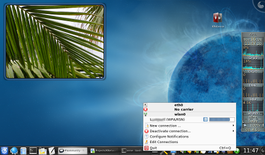KNetworkManager: Difference between revisions
No edit summary |
m (Update urls) |
||
| Line 12: | Line 12: | ||
[[Category:Internet]] | [[Category:Internet]] | ||
'''[http://en.opensuse.org/Projects/KNetworkManager The Project Page]''' gives an overview of features, some screenshots, and links to packages for several distros. | '''[http://old-en.opensuse.org/Projects/KNetworkManager The Project Page]''' gives an overview of features, some screenshots, and links to packages for several distros. | ||
More '''[http://en.opensuse.org/Projects/KNetworkManager_Screenshots screenshots]''' show its use on different desktop environments. | More '''[http://old-en.opensuse.org/Projects/KNetworkManager_Screenshots screenshots]''' show its use on different desktop environments. | ||
[[Category:KDE3]] | [[Category:KDE3]] | ||
Revision as of 12:58, 31 August 2010
Template:I18n/Language Navigation Bar
 |
Let KNetworkManager handle your open and encrypted connections. |
KNetworkManager is a KDE client for the back end Network Manager software. KNetworkManager communicates with Network Manager via DBus (a type of message passing software).
![]()
One typical usage is to connect to a wireless network with credentials known to the user. The user will setup a connection and KNetworkManager will store the settings wherever the user's configurations are stored. The configuration will include things like the name (ESSID) and passphrase used to associate with a particular wireless network. KNetworkManager can then use this information by packaging it into a DBus request to connect to a particular network. The Network Manager back end then does the low level operations required to actually setup the support software (e.g. pushing ESSID and key to wpa-supplicant) and bring up the network device with the appropriate settings.
Along with the advantage of allowing normal users to control the configuration the network. It also allows one consistent interface for network configuration on KDE, and other desktops (e.g. GNOME) can use the network manager back end without each having to implement the logic to handle network configuration. The Project Page gives an overview of features, some screenshots, and links to packages for several distros.
More screenshots show its use on different desktop environments.
